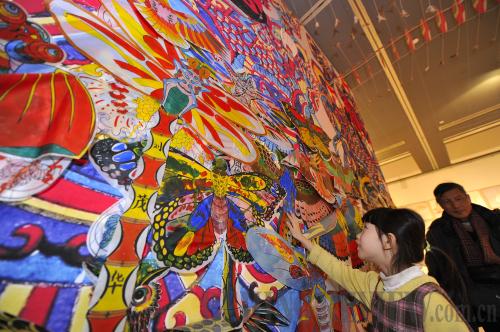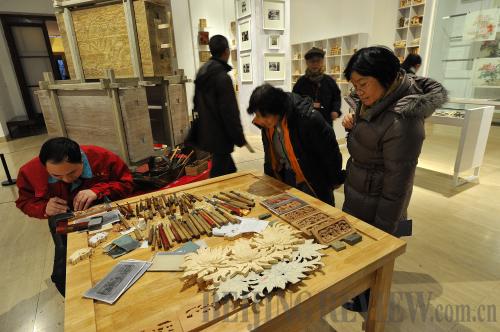|
New horizon
 |
|
HAVING FUN: A girl hangs a kite she made on the wall (SHI GANG) |
Begun in 2006, the handicrafts in the countryside project is partly the result of research conducted 30 years ago by Pan Lusheng, President of the Shandong University of Art and Design (SUAD).
Pan, who was born in 1962 in Caoxian County, has devoted much of his career to studying and protecting Chinese folk art. As part of his research, he visited more than 1,000 rural craftsmen, recorded 121 handicraft techniques, and collected over 30,000 handicrafts pieces. In 1989, he opened the country's first folk arts museum. In 2004, he even proposed an academic discipline revolving around Chinese handicrafts.
The project, according to Pan, has profound economic and cultural significance for China, which has 900 million farmers, including 230 million migrant workers from rural areas.
"Our research opens a new horizon for rural handicrafts," Pan said. "We can view rural areas from a cultural perspective, exploring new methods of developing culture in the countryside. We can take advantage of stay-at-home handicraft-making as a feasible solution for problems related to the aging population and migrant workers in the rural area."
 |
|
WATCHING CAREFULLY: Visitors watch wood carvings (SHI GANG) |
Pan's view was echoed by exhibition manager Zhao Yi, Dean of the School of Arts and Humanities at the SUAD. Zhao has been involved in Pan's research project since 1997. Zhao said the event meant a great deal to the farmers involved.
"This is the first time that rural handicrafts have been presented as a cultural project," said Zhao. "We'd like to attract more attention from the whole country. The countryside today should not be labeled as 'poor' or 'backward' anymore. It is a cradle of art."
"On the one hand, this kind of work can help increase farmers' income in their spare time without having to seek jobs elsewhere. On the other hand, it is not purely physical work, but also creative and artistic. It can help to make the countryside more modern and cultured," Zhao said.
"Handicrafts are part of life," Pan said. "They can make people in urban areas feel more connected to nature. I hope the exhibition and the project will encourage the protection of our intangible heritage, as well as help the craftsmen who make these works of art."
Yang Xianrang, 81, a printmaker and senior researcher on Chinese folk art, was deeply impressed by the exhibition.
"From an artistic angle, every exhibit here is a great work of art," he said.
"I saw a lot of art deco pieces when I was living in the United States. Looking around here, the pieces are fantastic!" Yang said. "From an economic angle, it is a great leap forward. It is a trend that will lead traditional rural handicrafts into a modern age." | 